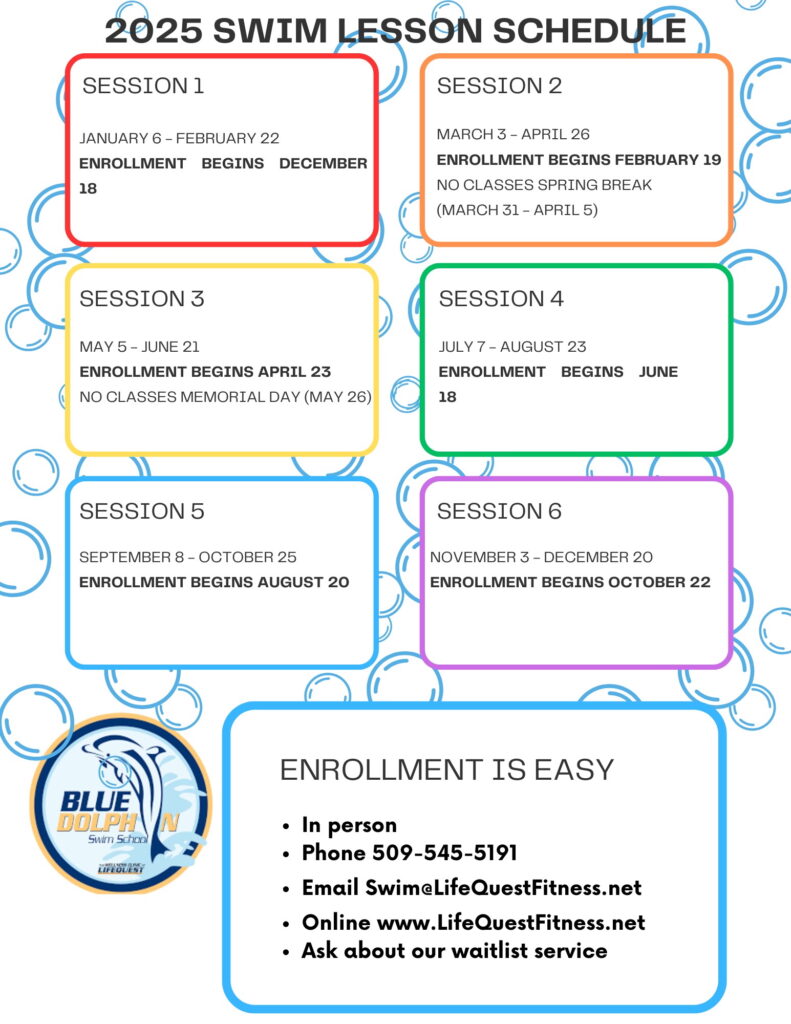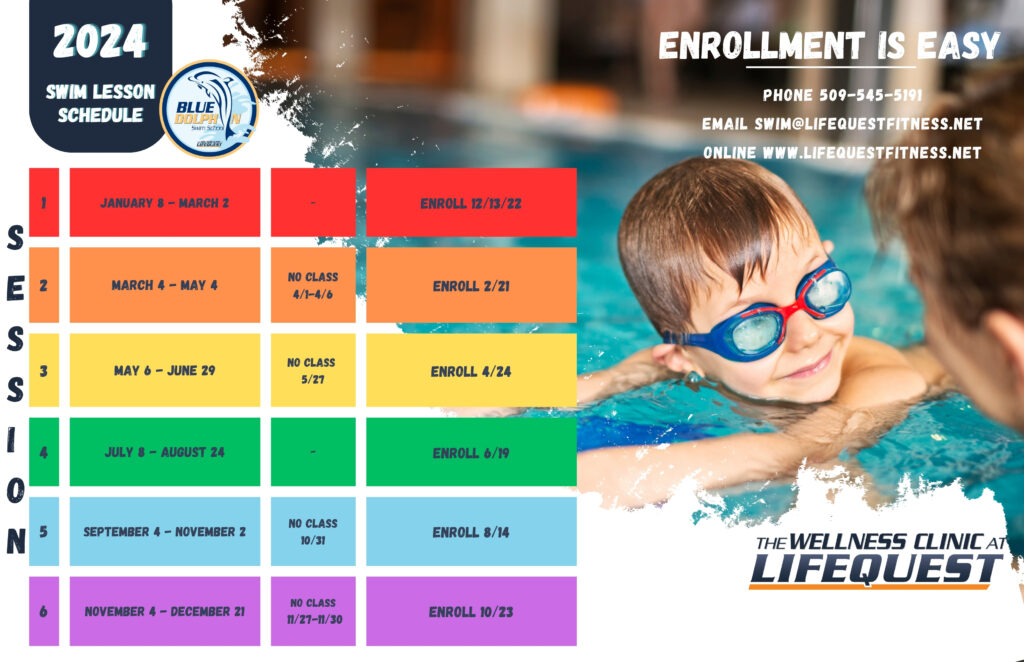blue dolphin swim school
Learn to swim!
Our 9 swim levels give children a platform to explore, grow and develop their swimming skills. Students will progressively learn a variety of skills that will allow them to be safe and comfortable in any aquatic environment, whether it is a pool, river, lake, or ocean. Please look below for class descriptions.
If you are unsure of your child’s swimming proficiency,
please contact us:
swim@lifequestfitness.net or call 509-545-5191.
-
Swim hours Mon-Fri 5am-9pm
Sat-Sun 8am-8pm
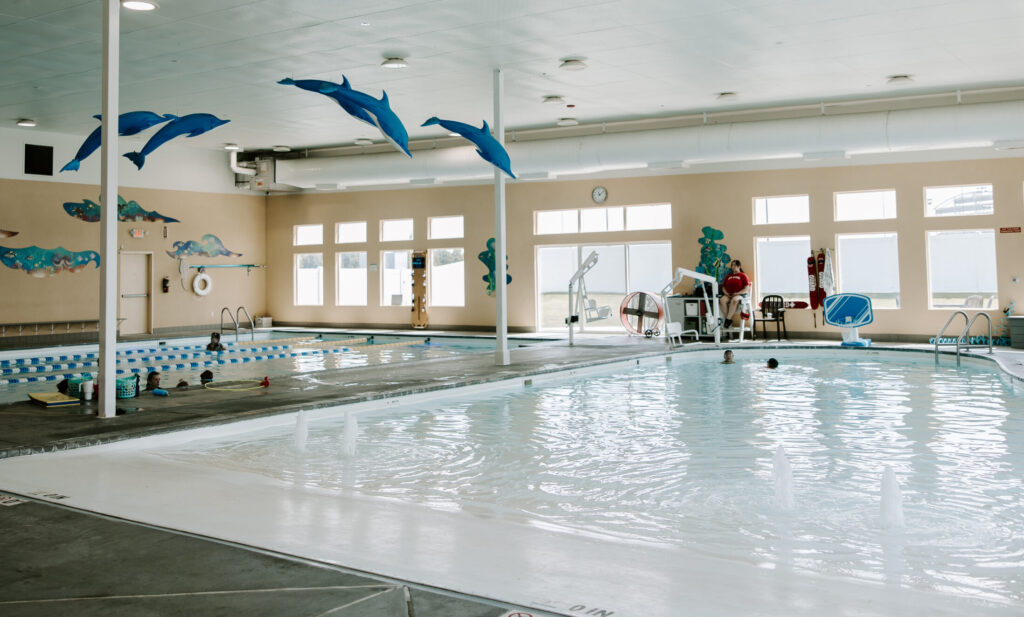
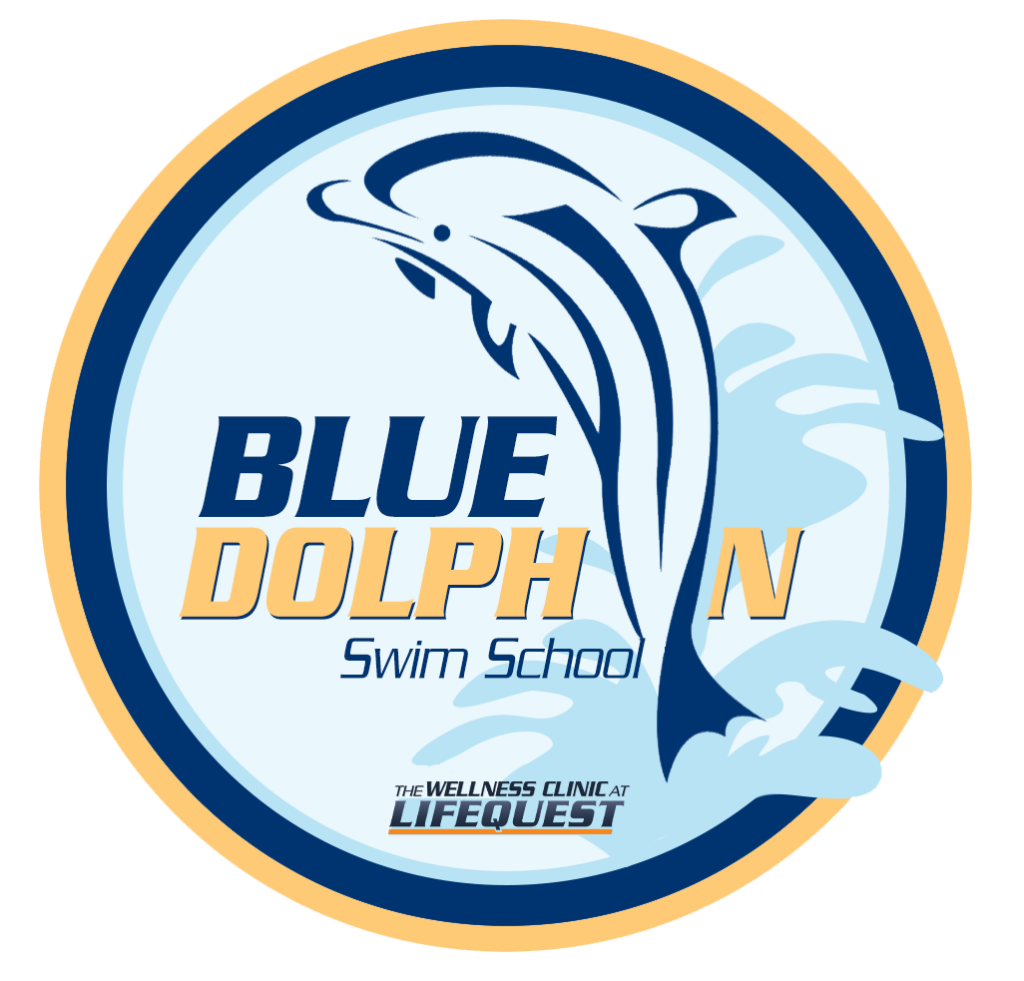
Learn to swim!

Our 9 swim levels give children a platform to explore, grow and develop their swimming skills. Students will progressively learn a variety of skills that will allow them to be safe and comfortable in any aquatic environment, whether it is a pool, river, lake, or ocean. Please look below for class descriptions.
If you are unsure of your child’s swimming proficiency,
please contact us:
swim@lifequestfitness.net or call 509-545-5191.
-
Swim hours Mon-Fri 5am-9pm
Sat-Sun 8am-8pm
Ages 6 Months - 4 Years old
Choose Your Class Below: Under 2.5 years old

JELLYFISH
PARENT TOT
• Under 2 1/2 years old
Choose Your Class Below: 2.5 years old to 4 years old
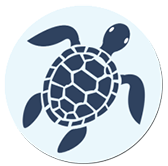
SEA TURTLES
• Little – No experience
• Not comfortable
• Cannot back float

SEA HORSES
• Comfortable submerging
• Can back float with assistance
• Rolls to front/back with assistance

SEA OTTERS
• Comfortable submerging
• Back floats with NO assistance
• Rolls to front/back with NO assistance
Ages 5 & Up
Choose Your Level Below: 5 Years Old & Up

MANTA RAYS
LEVEL 1
• Little – No experience
• Not comfortable
• Cannot back float

MARLINS
LEVEL 2
• Comfortable submerging
• Can back float with assistance
• Rolls to front/back with assistance
Choose Your Level Below: All Ages
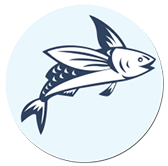
FLYING FISH
• All ages
• Must know freestyle arms
• Must know back stroke
• Strokes are not perfected

MAKO SHARKS
• All ages
• Perfected freestyle
• Perfected backstroke
• Breaststroke not perfected

ORCAS
• All ages
• Perfected freestyle/backstroke/breaststroke
• Butterfly not perfected
frequently asked questions
Levels in this swim program are divided by age and ability. If you are unsure of your child’s swimming proficiency, you may contact our Aquatics Director at 509-545-5191 ext. 121 or e-mail her at swim@lifequestfitness.net
Although it is possible to teach your children how to swim on your own, children are more susceptible to learning in a formal setting. Not only will kids progress at a faster rate, but they will also learn the correct technique without developing bad habits.
Our Parent-Tot classes starts as early as three months old. It has been proven it is a lot easier to teach an infant rather than a four or five year old who has already built up a fear to the water. However, taking the first step and enrolling a child of any age is the best possible gift you can give to your child. According to the AAP (American Academy of Pediatrics), new evidence shows that children 1 to 4 may be less likely to drown if they have had formal swimming instruction.”
Learning to swim is the only sport that can save a child’s life. Drowning is the second leading cause of accidental deaths in children under the age of 14. Learning to swim can save their life.
Our lessons are 30 minutes; 25 minutes of group instruction, 2-3 minutes of safety talks in the hot-tub and 2-3 minutes of communication to parents regarding the lesson.
Children learn through repetition, they did not learn to say “Thank you” or “Please” the first time they were taught, or learn their ABC’s the first time you sung it to them, it took daily repetition for time on end before children learn these simple tasks. Swimming is a not as easy as ABC’s or “Thank you”, it is a very complicated motor skill and while we can train the brain to know what to do, it takes longer for the muscles to react to the movements required. Swimming is an ongoing experience with new skills being learned regularly to reach new goals.
A swimming suit, towel and goggles. If your swimmer is newly potty trained or not potty trained, a swim diaper is required. If your swimmer has longer hair please secure it in a ponytail or wear a swim cap. Long hair can block their airway when they roll over to breathe, which makes success harder in beginning swimmers.
If your swimmer is newly potty trained or not potty trained a swim diaper is required.
Parents may observe the lessons from the Observation Room. Parents are discouraged from being on the pool deck. We ask that you attempt to be minimally visible because your presence distracts the children. They often become more interested in watching you than listening to the instructor.
Please do not feed your child or give them milk or juice one hour before the swim lesson. If your child is frightened or cannot hold their breath, no eating 3 hours before is preferred. Nervous children often swallow lots of air and sometimes water which may cause a student to throw-up
Blue Dolphin Swim School believes there is NO SUCH THING as being “Drown-Proofed”. We teach our students how to love and respect the water, and they can never swim alone. In fact, adults should never swim alone either!
Children learn at their own pace and in their own way. Each child’s individual personality, readiness, maturity, ability to follow directions, learning style, physical coordination, and practice time all effect how long it takes to learn to swim. There is also several fear factors to potentially come into play; learning to be comfortable and put their face in the water, learning to breathe correctly and then to push off from the side and trust the water will hold them up. These are major psychological steps.
Our instructors are committed to allowing each child to learn and develop at their own pace. We see learning to swim as part of a bigger picture and we value the opportunity to invest our lives in your children and accomplish our mission of growing happy, healthy responsible kids who love to learn and our as safe as can be around water.
Very often, a child may look great for a short distance. However, unless skills already learned are constantly practiced and consolidated, the endurance and aerobic fitness needed to swim any distance is missing. Plateaus are common, especially when a child faces a hurdle that is especially difficult for them.
Our teachers are sensitive to these issues and are trained to motivate and guide swimmers though these peaks and valleys. Parents should be prepared to spend a couple of sessions at each level in the beginning levels to make sure the skills become second nature, and the swimmer lays the foundation to become a strong accomplished swimmer for life.
Our staff constantly evaluates the swimmers. At the same time, remember, not to rush it. Each level builds upon your child’s ability to master the last level. A child rushed through our program will never be as good as the child that takes the time to master each skill. Parents please remember that the journey from first blowing bubbles to swimming 50 yards takes several years. Therefore, it is impractical to expect your child to master each skill level the first time they attempt it. Please be patient and supportive with your child! This is a skill that will last your child a lifetime.
Remain calm. Anxiety and crying are often exhibited by children who have a fear of the water, especially in children that are 2 1/2 years of age and older. Being comfortable in the water with floaties or water wings is NOT considered being comfortable in the water. Please be assured that a crying child in lessons is not uncommon around the swim school. Our great staff of instructors will establish trust with their students and find creative ways to ease into this new experience.
Our instructors are well trained in dealing with crying children.
We have a few suggestions for parents:
- Give your child to the instructor. Keep a pleasant look on your face and hand them over to the teacher. Then calmly exit out of the pool area with a pleasant expression on your face. By handing your child over to the teacher, you are telling your child that YOU trust the teacher. Until your child has transitioned, stay out of sight.
- Praise and encouragement after lessons is very important! Don’t forget children are actually learning even if they are crying. Muscles are being built, coordination is increased, correct patterns are developing in the brain, and breathing control is increased.
- Remain Calm. DO NOT allow your child to be the decision maker as to whether or not he will attend and continue swim lessons. As the adult, you must reassure your child that learning to swim is something he must do for his own safety. Reassure your child that the Blue Dolphin Swim School Instructors will take very good care of him.
- HANG IN THERE: Parents can become discouraged because their child may be exhibiting fear. Just take a deep breath and relax. We have seen it many times. The children do get through it. Once they get through the fear and anxiety, the joy they have in the water begins to take over.
- Talk to them about all the FUN things they did during their swimming lesson. Talk to them about their teacher, the songs, the games, the backfloats or anything else the child may have liked. The more you have happy discussions at home about it the faster they will be willing to try and the faster they will accept the water.
NO. It will only get worse as the child gets older and develops more anxieties and fears about the water. Hang in there; they typically get through this in 2-3 classes. Swimming, like many activities, generates anxiety in some children. This anxiety may be most evident on the first day of lessons.
As each week progresses, your child’s anxiety should be less and less evident. That is why we schedule multi-week sessions. Time, familiarity and consistency ease the anxiety. You can help your child through this period by reinforcing skills learned during lessons through play time in the pool, bathtub, shower and through discussions with them regarding swim lessons.
It is very dependent on what age the child started, how comfortable they are in the water and the speed at which they are progressing. No two children will learn at the same pace and each child will have different hurdles to overcome through their swim journey.
Blue Dolphin Swim School is designed to get your child through beginning lessons to advanced lessons. When they have completed Level 5 Orcas of our swim program is when we feel comfortable telling you that your child can swim independently and understands water safety. However, we NEVER advise them to swim on their own under any circumstances.
Once a child learns how to swim there are many advantages to keeping them in an ongoing program. Not only do children benefit from becoming strong swimmers but they also benefit from lifesaving programs, competitive swimming, and the ability to do a variety of strokes. Along with all of the health and wellness benefits swimming has to offer.
As stated by the AAP, it is not recommended to use air filled swimming aids such as floaties/water wings. While flotation devices are a valuable teaching tool, we do not promote prolonged use of
flotation devices of any kind for teaching swimming skills. When “floatie” devices are used repetitively, children become accustomed to a vertical position and it makes it more difficult for them to adjust to a horizontal position – which is the position that is the safest and most efficient position for them in the water.
However, we do consider safety of the utmost importance and believe that flotation devices, such as USCG approved lifejackets or Puddle Jumpers, should be used in aquatic settings to protect children.

